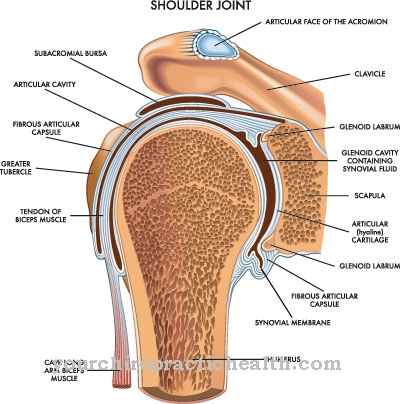Growing pains are usually not a cause for concern in children. However, if the pain recurs not only after activities but also at rest, a doctor should be consulted. The Ewing's sarcoma can cause this discomfort.
What is Ewing's sarcoma?

© Artemida-psy - stock.adobe.com
Ewing's sarcoma was first described by James Ewing and is a form of bone cancer that usually develops in the thigh bones or in the pelvis.
The ribs are less often affected. However, the sarcoma can affect all other bones in the human skeleton. The extremely malignant tumor occurs mainly in children and adolescents between the ages of 10 and 25 years, with boys being affected much more frequently than girls.
The main characteristic of Ewing's sarcoma is its rapid growth and thus the risk of spreading unhindered to other bones and the lungs. If left untreated, Ewing's sarcoma leads to death within a few months.
causes
So far, no cause for the development of Ewing's sarcoma has been found. The assumptions that hereditary factors or a previous exposure to radiation that was too high due to radiation therapy were the cause of the tumor could not be confirmed.
However, certain recurring gene changes on chromosome 22 could be linked to the tumor. However, the inheritance of this gene mutation has not been proven, so it remains unclear what causes the growth of the malignant Ewing's sarcoma.
You can find your medication here
➔ Medicines for joint painSymptoms, ailments & signs
The symptoms of Ewing's sarcoma are unspecific, as they can also occur with other diseases or with growth disorders. In the beginning, those affected often complain of recurring pain, which usually increases with exercise. However, these persist at night. The pain may appear for the first time after a minor trauma.
Since the disease affects adolescents, it is often initially assumed that it is growing pain or injury pain. Swelling and redness appear on the affected area. Sometimes it can even lead to failure symptoms if the spine or peripheral nerves are involved in the disease process. The larger the tumor, the more often functional impairments occur.
At this stage there are often no metastases. If, however, general symptoms such as fever, weight loss or fatigue are added, this can indicate existing metastases. If treated early before metastases develop, there is a 65 percent chance of recovery.
However, even years later, there is still a risk of a relapse if the cancer has not been completely eliminated by therapy. Nevertheless, even completely tumor-free patients often continue to suffer from the consequences of therapy under various symptoms. The prognosis is worse in patients with metastases. The symptoms they experience depend on the organs affected by the metastases.
Diagnosis & course
Ewing's sarcoma causes pain and swelling in the affected area of the patient's body. The pain persists even at rest and usually occurs irregularly. As a result, they are often misinterpreted and not associated with a serious medical condition.
When the tumor has reached a certain size, the patient experiences restricted mobility and sometimes also reddening of the affected area, which ultimately leads him to the doctor. A quarter of those affected have metastasized at this stage and the cancer has spread to other regions of the body.
The diagnosis of Ewing's sarcoma is first made on the basis of blood tests, which can be confirmed by imaging methods such as X-rays and computed tomography (CT) or magnetic resonance imaging (MRI). A biopsy is used to precisely determine the sarcoma. This involves taking a tissue sample from the tumor.
Possible metastases in the lungs are searched for using imaging techniques. In order to determine whether the bone marrow has already been affected by Ewing's sarcoma, a bone marrow puncture is necessary.
Complications
Ewing's sarcoma tumor grows rapidly and often affects the lungs. If left untreated, death can be expected within a few months. However, those who decide early on for medical and drug treatment have a very good chance of a prompt and complete recovery.
In most cases, Ewing's sarcoma occurs in children who are in the growth phase. The patients suffer from resting pain that occurs even without movement. There is often a fever and pain in the bones and joints, even if they are not moved. Swelling and redness can also develop there. In the pronounced stage, Ewing's sarcoma leads to restrictions in movement and thus in everyday life.
The sufferer feels tired and unable to do physical activity. If Ewing's sarcoma is left untreated, death can result. Therefore, the treatment is always based on the removal of the tumor, after which chemotherapy is recommended. Unfortunately, there is no guarantee that the tumor will not recur. It is not uncommon for the patient to repeat the treatment.
With a repeated illness, the chances of a cure are much lower than with the first illness. If Ewing's sarcoma cannot be treated, the pain is relieved so that the patient can live his everyday life in the normal way. Life expectancy is drastically reduced due to illness.
When should you go to the doctor?
Ewing's sarcoma is an explicit type of bone cancer that mostly affects young men between the ages of 10 and 25. Affected people usually complain of pain in their limbs, so stabbing pain can occur even when at rest. A doctor should be seen if certain parts of the body are painful for no apparent reason.
Ewing's sarcoma can only be identified through a thorough medical examination. An early diagnosis is also very important for the later course of the disease, because only then can a full recovery take place. If a visit to the doctor is postponed, the bone cancer can attack vital organs and thus lead to death.
Doctors & therapists in your area
Treatment & Therapy
When treating Ewing's sarcoma, an attempt is first made to surgically remove the tumor. Then the patient receives radiation therapy and chemotherapy.
Due to the rapid growth of the tumor cells, metastases often occur even after the original tumor has been removed, which can be avoided by this procedure. Radiation therapy is used either during or between two phases of chemotherapy. The total duration of treatment for Ewing's sarcoma is 10 to 12 months. Despite modern and constantly improved therapy methods, relapses occur in 30 to 40 percent of patients.
With these so-called relapses, the chances of a cure are much lower than with the first illness, because there is currently no standardized treatment. Attempts are made to surgically remove the tumor again or to shrink it using combined chemotherapy and radiation therapy. A particularly high-dose chemotherapy is often used.
If all therapeutic measures remain unsuccessful, palliative medicine tries to relieve the patient's pain. The global analysis of treatment protocols aims to optimize the currently possible therapeutic measures and to improve the survival chances of patients suffering from Ewing's sarcoma in the long term.
Outlook & forecast
The prognosis of Ewing's sarcoma depends on the location of the tumor, the start of treatment and its responsiveness to the chemotherapeutic agents used. There is a good response to chemotherapeutic agents when the residual tumor mass contains less than ten percent living tumor cells. If more than ten percent of living tumor cells remain, this shows a poor response to chemotherapy.
Furthermore, the prognosis of the disease is much better if there are no metastases at the start of treatment. In addition, it has been observed that the 5-year survival rate for extremity bones (60-70 percent) is higher than for pelvic bones (40 percent). The possibility of complete surgical tumor removal also plays a role in the prognosis. If the tumor has not yet spread and is at the same time very accessible for an operation, there is of course a very good chance of a complete cure.
Inoperable tumors are irradiated. The statistical data cannot be used to predict whether the individual affected can be cured. This even applies to patients who have already metastasized. The statistical data only give the probability.
In addition, therapy optimization studies are constantly being carried out in order to improve the prognosis even in advanced stages of the disease. However, it must also be noted that even completely tumor-free patients are often not free of symptoms due to undesirable side effects of the therapy.
You can find your medication here
➔ Medicines for joint painprevention
There are no direct preventive measures against Ewing's sarcoma. However, recurring pain should always be taken seriously in children and adolescents, as this tumor grows extremely quickly and can spread through metastases in the body. The earlier Ewing's sarcoma is detected, the faster targeted treatment can be given.
Aftercare
After successful treatment of Ewing's sarcoma, regular follow-up examinations ensure that new tumor formation or metastases in other organs can be detected and treated at an early stage. Long-term effects of chemotherapy or radiation therapy can also be recorded in good time. Each follow-up appointment includes a detailed physical examination, during which the area around the healed tumor in particular is carefully examined.
X-ray examinations, computed tomography (CT), magnetic resonance imaging (MRI) or ultrasound examinations are also carried out as required. Occasionally, skeletal scintigraphy may also be necessary. As a rule, an X-ray of the lungs every two months and an X-ray or MRI examination of the primary tumor region every four months are recommended for Ewing sarcoma patients for the first two years.
In the third year the intervals are extended to three or six months, in the fourth year a six-monthly x-ray check of the lungs is useful to rule out lung metastases. From the fifth year this is only necessary once a year.
Since chemotherapy can cause long-term effects on the heart, cardiac function should be checked once a year for ten years using an electrocardiogram (EKG) and heart ultrasound (echocardiography). If there are no symptoms, a routine examination every two years is sufficient. An annual blood and urine test to check kidney function is also recommended for the first three years.
You can do that yourself
Ewing's sarcoma is a form of bone cancer that particularly affects children and adolescents. The earlier the disease is discovered and therapy is started, the greater the chances of recovery. Parents should therefore consult a doctor as soon as possible if their children complain about certain symptoms and not trivialize them.
A bone tumor is usually noticeable through pain in the affected area. Often the skin and the tissue over the diseased bone area is swollen or inflamed. If parents observe such symptoms in their children, a doctor should always be consulted as a precaution, even if the causes are harmless in most cases.
Not every bruise conceals a fatal disease, but preventive measures are still advisable. Even if children and adolescents constantly complain about aching arms or legs, this should not simply be dismissed as "growth problems", but taken seriously and clarified by a doctor.
If bone cancer is actually diagnosed, the young patients usually suffer very badly from the side effects of chemotherapy. Parents and sick children should seek contact with other affected persons in order to better cope with the psychological stresses associated with the illness. Self-help groups are no longer only active locally, but also on the Internet. If necessary, psychological support is also indicated.

.jpg)




.jpg)

















.jpg)



